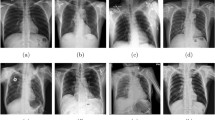Abstract
The chest X-ray (CXR) is a widely used and easily accessible medical test for diagnosing common chest diseases. Recently, there have been numerous advancements in deep learning-based methods capable of effectively classifying CXR. However, assessing whether these algorithms truly capture the cause-and-effect relationship between diseases and their underlying causes, or merely learn to map labels to images, remains a challenge. In this paper, we propose a causal approach to address the CXR classification problem, which involves constructing a structural causal model (SCM) and utilizing backdoor adjustment to select relevant visual information for CXR classification. Specifically, we design various probability optimization functions to eliminate the influence of confounding factors on the learning of genuine causality. Experimental results demonstrate that our proposed method surpasses the performance of two open-source datasets in terms of classification performance. To access the source code for our approach, please visit: https://github.com/zc2024/Causal_CXR.
Access this chapter
Tax calculation will be finalised at checkout
Purchases are for personal use only
Similar content being viewed by others
References
Brady, A., Laoide, R.Ó., McCarthy, P., McDermott, R.: Discrepancy and error in radiology: concepts, causes and consequences. Ulster Med. J. 81(1), 3 (2012)
Glymour, M., Pearl, J., Jewell, N.P.: Causal Inference in Statistics: A Primer. Wiley, Hoboken (2016)
Gong, X., Xia, X., Zhu, W., Zhang, B., Doermann, D., Zhuo, L.: Deformable Gabor feature networks for biomedical image classification. In: Proceedings of the IEEE/CVF Winter Conference on Applications of Computer Vision, pp. 4004–4012 (2021)
Gündel, S., Grbic, S., Georgescu, B., Liu, S., Maier, A., Comaniciu, D.: Learning to recognize abnormalities in chest x-rays with location-aware dense networks. In: Vera-Rodriguez, R., Fierrez, J., Morales, A. (eds.) CIARP 2018. LNCS, vol. 11401, pp. 757–765. Springer, Cham (2019). https://doi.org/10.1007/978-3-030-13469-3_88
He, K., Zhang, X., Ren, S., Sun, J.: Deep residual learning for image recognition. In: Proceedings of the IEEE Conference on Computer Vision and Pattern Recognition, pp. 770–778 (2016)
Irvin, J., et al.: Chexpert: a large chest radiograph dataset with uncertainty labels and expert comparison. In: Proceedings of the AAAI Conference on Artificial Intelligence, vol. 33, pp. 590–597 (2019)
Ke, A., Ellsworth, W., Banerjee, O., Ng, A.Y., Rajpurkar, P.: CheXtransfer: performance and parameter efficiency of ImageNet models for chest x-ray interpretation. In: Proceedings of the Conference on Health, Inference, and Learning, pp. 116–124 (2021)
Kingma, D.P., Ba, J.: Adam: a method for stochastic optimization. arXiv preprint arXiv:1412.6980 (2014)
Liu, H., Wang, L., Nan, Y., Jin, F., Wang, Q., Pu, J.: SDFN: segmentation-based deep fusion network for thoracic disease classification in chest x-ray images. Comput. Med. Imaging Graph. 75, 66–73 (2019)
Mao, C., Yao, L., Luo, Y.: ImageGCN: multi-relational image graph convolutional networks for disease identification with chest x-rays. IEEE Trans. Med. Imaging 41(8), 1990–2003 (2022)
Ouyang, X., et al.: Learning hierarchical attention for weakly-supervised chest x-ray abnormality localization and diagnosis. IEEE Trans. Med. Imaging 40(10), 2698–2710 (2020)
Pan, X., et al.: On the integration of self-attention and convolution. In: Proceedings of the IEEE/CVF Conference on Computer Vision and Pattern Recognition, pp. 815–825 (2022)
Pearl, J.: Interpretation and identification of causal mediation. Psychol. Methods 19(4), 459 (2014)
Pearl, J., et al.: Models, reasoning and inference. Cambridge, UK: Cambridge University Press 19(2) (2000)
Pham, H.H., Le, T.T., Tran, D.Q., Ngo, D.T., Nguyen, H.Q.: Interpreting chest x-rays via CNNs that exploit hierarchical disease dependencies and uncertainty labels. Neurocomputing 437, 186–194 (2021)
Rajaraman, S., Antani, S.: Training deep learning algorithms with weakly labeled pneumonia chest x-ray data for covid-19 detection. MedRxiv (2020)
Rocha, J., Pereira, S.C., Pedrosa, J., Campilho, A., Mendonça, A.M.: Attention-driven spatial transformer network for abnormality detection in chest x-ray images. In: 2022 IEEE 35th International Symposium on Computer-Based Medical Systems (CBMS), pp. 252–257. IEEE (2022)
Saleem, H.N., Sheikh, U.U., Khalid, S.A.: Classification of chest diseases from x-ray images on the CheXpert dataset. In: Mekhilef, S., Favorskaya, M., Pandey, R.K., Shaw, R.N. (eds.) Innovations in Electrical and Electronic Engineering. LNEE, vol. 756, pp. 837–850. Springer, Singapore (2021). https://doi.org/10.1007/978-981-16-0749-3_64
Sui, Y., Wang, X., Wu, J., Lin, M., He, X., Chua, T.S.: Causal attention for interpretable and generalizable graph classification. In: Proceedings of the 28th ACM SIGKDD Conference on Knowledge Discovery and Data Mining, pp. 1696–1705 (2022)
Vaswani, A., et al.: Attention is all you need. In: Advances in Neural Information Processing Systems, vol. 30 (2017)
Wang, X., Peng, Y., Lu, L., Lu, Z., Bagheri, M., Summers, R.M.: Chestx-ray8: hospital-scale chest x-ray database and benchmarks on weakly-supervised classification and localization of common thorax diseases. In: Proceedings of the IEEE Conference on Computer Vision and Pattern Recognition, pp. 2097–2106 (2017)
Wu, J. et al.: SeATrans: learning segmentation-assisted diagnosis model via transformer. In: Wang, L., Dou, Q., Fletcher, P.T., Speidel, S., Li, S. (eds.) Medical Image Computing and Computer Assisted Intervention - MICCAI 2022. MICCAI 2022. LNCS, vol. 13432, pp 677–687. Springer, Cham (2022). https://doi.org/10.1007/978-3-031-16434-7_65
Wu, J., et al.: Calibrate the inter-observer segmentation uncertainty via diagnosis-first principle. arXiv preprint arXiv:2208.03016 (2022)
Wu, J. et al.: Opinions vary? Diagnosis first!. In: Wang, L., Dou, Q., Fletcher, P.T., Speidel, S., Li, S. (eds.) Medical Image Computing and Computer Assisted Intervention - MICCAI 2022. MICCAI 2022. LNCS, vol. 13432, pp. 604–613. Springer, Cham (2022). https://doi.org/10.1007/978-3-031-16434-7_58
Wu, J., et al.: Leveraging undiagnosed data for glaucoma classification with teacher-student learning. In: Martel, A.L., et al. Medical Image Computing and Computer Assisted Intervention - MICCAI 2020. MICCAI 2020. LNCS, vol. 12261, pp. 731–740. Springer, Cham (2020). https://doi.org/10.1007/978-3-030-59710-8_71
Zhang, Y., Kang, B., Hooi, B., Yan, S., Feng, J.: Deep long-tailed learning: a survey. arXiv preprint arXiv:2110.04596 (2021)
Acknowledgement
This work was supported by the National Natural Science Foundation of China (62272337).
Author information
Authors and Affiliations
Corresponding author
Editor information
Editors and Affiliations
Rights and permissions
Copyright information
© 2023 The Author(s), under exclusive license to Springer Nature Switzerland AG
About this paper
Cite this paper
Nie, W., Zhang, C., Song, D., Bai, Y., Xie, K., Liu, AA. (2023). Chest X-ray Image Classification: A Causal Perspective. In: Greenspan, H., et al. Medical Image Computing and Computer Assisted Intervention – MICCAI 2023. MICCAI 2023. Lecture Notes in Computer Science, vol 14222. Springer, Cham. https://doi.org/10.1007/978-3-031-43898-1_3
Download citation
DOI: https://doi.org/10.1007/978-3-031-43898-1_3
Published:
Publisher Name: Springer, Cham
Print ISBN: 978-3-031-43897-4
Online ISBN: 978-3-031-43898-1
eBook Packages: Computer ScienceComputer Science (R0)





